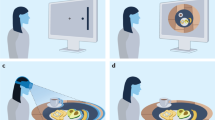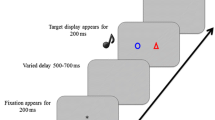Summary
Naive human subjects (N=18) were asked to move a manipulandum on a plane in directions other than going straight towards a visual stimulus. They were instructed verbally to generate a movement at an angle from a stimulus direction which varied in 2-dimensional (2-D) space from trial to trial in a pseudorandom fashion. Each subject performed eight sets of twenty consecutive trials: one for moving in the stimulus direction and seven for moving in directions at an angle from it. The angles were 5, 10, 15, 35, 70, 105 and 140°. Nine subjects were instructed to move in the clockwise (CW) departure and 9 to move in either (EI) the clockwise or the counterclockwise (CCW) departure, as they wished. The direction of the movement in 2-D space and the reaction time (RT) were measured. The mean angle achieved in a given set overshot the instruction angle, especially in the lower range (5–35°). The reaction time, (RTΘ), of movements made at an angle from the stimulus direction showed two kinds of change: first, a step increase from the reaction time, RT0, of movements in the stimulus direction, and second, superimposed upon it, a linear increase with the amplitude of the angle. The slope of the line was similar for the CW (2.37 ms/degree) and the EI case (2.28 ms/degree), but the step increase (y-intercept) for the EI case (84 ms) was substantially less than that of the CW case (155 ms). The linear increase of the RT with angle is compatible with the idea that performance in the task may involve a mental rotation of the imagined movement vector about its origin. The rotation would begin from the stimulus direction and end when the required angle is judged to have been reached; in addition, corrections of this angle at the end of the rotation could be made. The slope of 2.37 ms/degree observed in the CW case would correspond to a rotation rate of 422 degrees/s. The finding of a similar rate for the EI case indicates a similarity in strategy with regard to achieving a desired angle. In contrast, the lower intercept observed for the EI case suggests significant savings in processing information which is unconstrained with regard to angular departure. Assuming this model of internal motion, we analyzed the amplitude-accuracy relations using Fitts' (1954) approach to real movements. In accordance with Fitts' law, we found that the increase in RT, considered as a mental movement time, was a linear function of task difficulty which was calculated from the angle achieved and its variability. This indicates that Fitts' law holds for the hypothesized rotatory motion of the imagined movement vector, and that both real and imagined movements might be governed by similar amplitude-accuracy relations.
Similar content being viewed by others
References
Cooper LA, Shepard RN (1973) Chronometric studies of the rotation of mental images. In: Chase WG (ed) Visual information processing. Academic, New York, pp 75–176
Crutcher MD, Schwartz AB, Georgopoulos AP (1985) Representation of movement direction in primate motor cortex in the absence of immediate movement. Soc Neurosci Abstr 11: 1273
Donders FC (1969) On the speed of mental processes. Acta Psychologica 30: 412–431 (Translated from the original by Koster WG from Onderzoekingen gedaan in het Physiologisch Laboratorium der Utrechtsche Hoogeschool (1868), Tweede reeks II: 92–120)
Duncan J (1977) Response selection rules in spatial choice reaction tasks. In: Dornic S (ed) Attention and performance VI. Erlbaum, Hillsdale NJ, pp 49–61
Fitts PM (1954) The information capacity of the human motor system in controlling the amplitude of movement. J Exp Psychol 46: 381–391
Fitts PM, Deininger RL (1954) S-R compatibility: correspondence among paired elements within stimulus and response codes. J Exp Psychol 48: 483–492
Fitts PM, Seeger (1953) S-R compatibility: spatial characteristics of stimulus and response codes. J Exp Psychol 46: 199–210
Fitts PM, Switzer G (1962) Cognitive aspects of information processing. I. The familarity of S-R sets and subsets. J Exp Psychol 63: 321–329
Georgopoulos AP, Kalaska JF, Massey JT (1981) Spatial trajectories and reaction times of aimed movements: effects of practice, uncertainty and change in target location. J Neurophysiol 46: 725–743
Georgopoulos AP, Caminiti R, Kalaska JF, Massey JT (1983) Spatial coding of movement: a hypothesis concerning the coding of movement direction by motor cortical populations. Exp Brain Res (Suppl) 7: 327–336
Georgopoulos AP, Kalaska JF, Crutcher MD, Caminiti R, Massey JT (1984) The representation of movement direction in the motor cortex: single cell and population studies. In: Edelman GM, Gall WE, Cowan WM (eds) Dynamic aspects of neocortical function. Wiley, New York, pp 501–524
Hick WE (1952) On the rate of gain of information. Q J Exp Psychol 4: 11–26
Hyman R (1953) Stimulus information as a determinant of reaction time. J Exp Psychol 45: 188–196
Kalaska JF, Caminiti R, Georgopoulos AP (1983) Cortical mechanisms related to the direction of two-dimensional arm movements: relations in area 5 and comparison with motor cortex. Exp Brain Res 51: 247–260
Keele SW (1981) Behavioral analysis of movement. In: Brookhart JM, Mountcastle VB, Brooks VB, Geiger SR (eds) Handbook of physiology, Vol 2. The nervous system: motor control, part 2. American Physiological Society, Baltimore MD, pp 1391–1414
Mardia KV (1972) Statistics of directional data. Academic Press, New York
Mowbray GH, Rhoades MV (1959) On the reduction of choice reaction times with practice. Q J Exp Psychol 11: 16–23
Rosenbaum DA (1980) Human movement initiation: specification of arm, direction, and extent. J Exp Psychol General 109: 444–474
Rosenbaum DA (1983) The movement precuing technique: assumptions, applications and extensions. In: Magill RA (ed) Memory and control of action. North-Holland, Amsterdam, pp 231–274
Shepard RN (1982) On turning something over in one's mind. In: Shepard RN, Cooper LA (eds) Mental images and their transformations. MIT Press, Cambridge London, pp 19–24
Shepard RN, Metzler J (1971) Mental rotation of three-dimensional objects. Science 171: 701–703
Snedecor GW, Cochran WG (1980) Statistical methods (7th edn). Iowa State University Press, Ames IA
Sternberg S (1966) High speed scanning in human memory. Science 153: 652–654
Sternberg S (1969) The discovery of processing stages: extensions of Donder's method. In: Koster WG (ed) Attention and performance II. Acta Psychol 30: 276–315
Author information
Authors and Affiliations
Rights and permissions
About this article
Cite this article
Georgopoulos, A.P., Massey, J.T. Cognitive spatial-motor processes. Exp Brain Res 65, 361–370 (1987). https://doi.org/10.1007/BF00236309
Received:
Accepted:
Issue Date:
DOI: https://doi.org/10.1007/BF00236309




